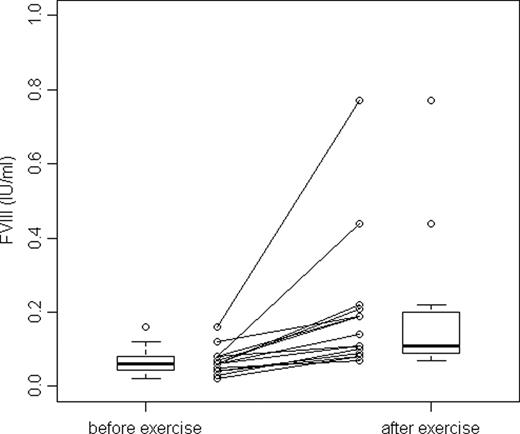Abstract
Abstract 545
An increase of clotting factor VIII (FVIII) within 10 minutes after physical exercise has been reported in healthy subjects and patients with von Willebrand disease. The mechanism of FVIII increase through exercise is thought to be similar to that of desmopressin, which increases FVIII. Therefore, moderate and mild haemophilia A patients should also be able to increase their endogenous FVIII levels after exercise. A proof of principle study was performed to test this hypothesis.
Changes in coagulation associated with exercise of 15 haemophilia A patients, aged 20–39 years, were measured. Eight had moderate haemophilia (FVIII 1–5 IU/dl), 7 had mild haemophilia with endogenous FVIII activity levels at the lower end of the range (FVIII 6–16 IU/dl) Patients were encouraged to cycle until volitional exhaustion, on an electronically braked cycle ergometer. Blood samples were drawn before and 10 minutes after the incremental exercise test. Blood was frozen and analyzed for FVIII, von Willebrand factor (vWF) and von Willebrand propeptide (vWpr), in one batch to avoid inter-assay variation. In mild haemophilia patients, changes in coagulation profile were compared to DDAVP tolerance tests.
All 15 patients had an increased FVIII level after exercise. Median relative increase was 2.5 times (interquartile range (IQR)= 1.2–4.0). The relative increase did not vary across severities (median relative increase of FVIII was 2.4 times (IQR= 1.3–4.0) for moderate haemophilia patients compared to median 2.5 times (IQR=1.2-4.0) in patients with mild haemophilia Mann-Whitney: p =0.91). However, the absolute FVIII levels were very different with a median FVIII level of only 9 IU/dl; IQR= 8–11 IU/dl) in patients with moderate haemophilia, compared with a much higher median FVIII level of 21 IU/dl; IQR=19-44 IU/dl) attained in patients with mild haemophilia. vWF and vWFpr also increased independent of severity (p=0.3-0.6) in all patients, median 50%; IQR 30–79% for vWF and median 165%; IQR 130–244% for vWFpr, reflecting acute release of coagulation factors. DDAVP response tests were available only for patients with mild haemophilia. Relative increase after DDAVP administration was median 3.5 times (IQR= 2.5–4.5), similar to increase in FVIII after exercise (Wilcoxon: p=0.14).
Although normal levels were not achieved, the increase of FVIII activity during exercise may reduce bleeding risk and therefore help promote participation in sports and other strenuous activities for moderate and mild haemophilia A patients with modest endogenous FVIII activities who might be considered at high bleeding risk.
FVIII levels in patients with moderate and mild haemophilia before and after an incremental exercise test
FVIII levels in patients with moderate and mild haemophilia before and after an incremental exercise test
No relevant conflicts of interest to declare.
Author notes
Asterisk with author names denotes non-ASH members.


This feature is available to Subscribers Only
Sign In or Create an Account Close Modal